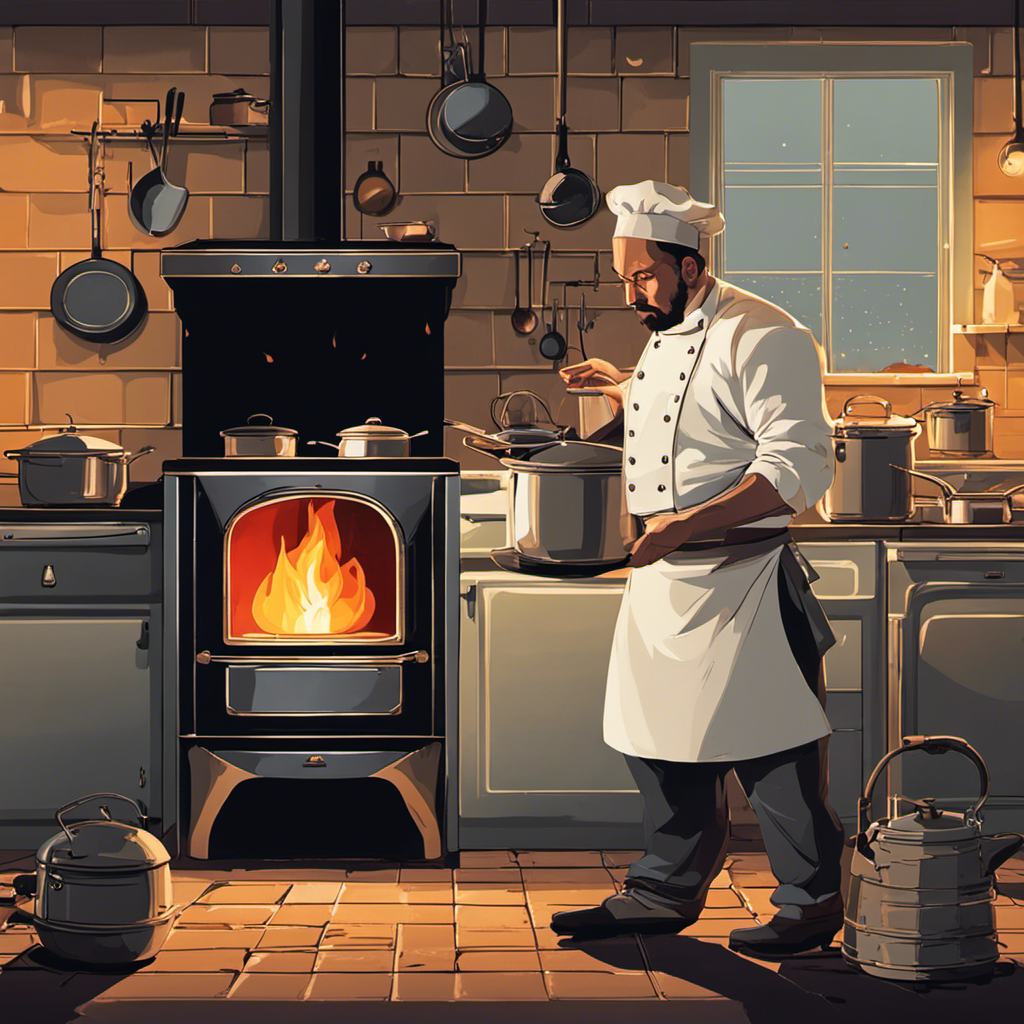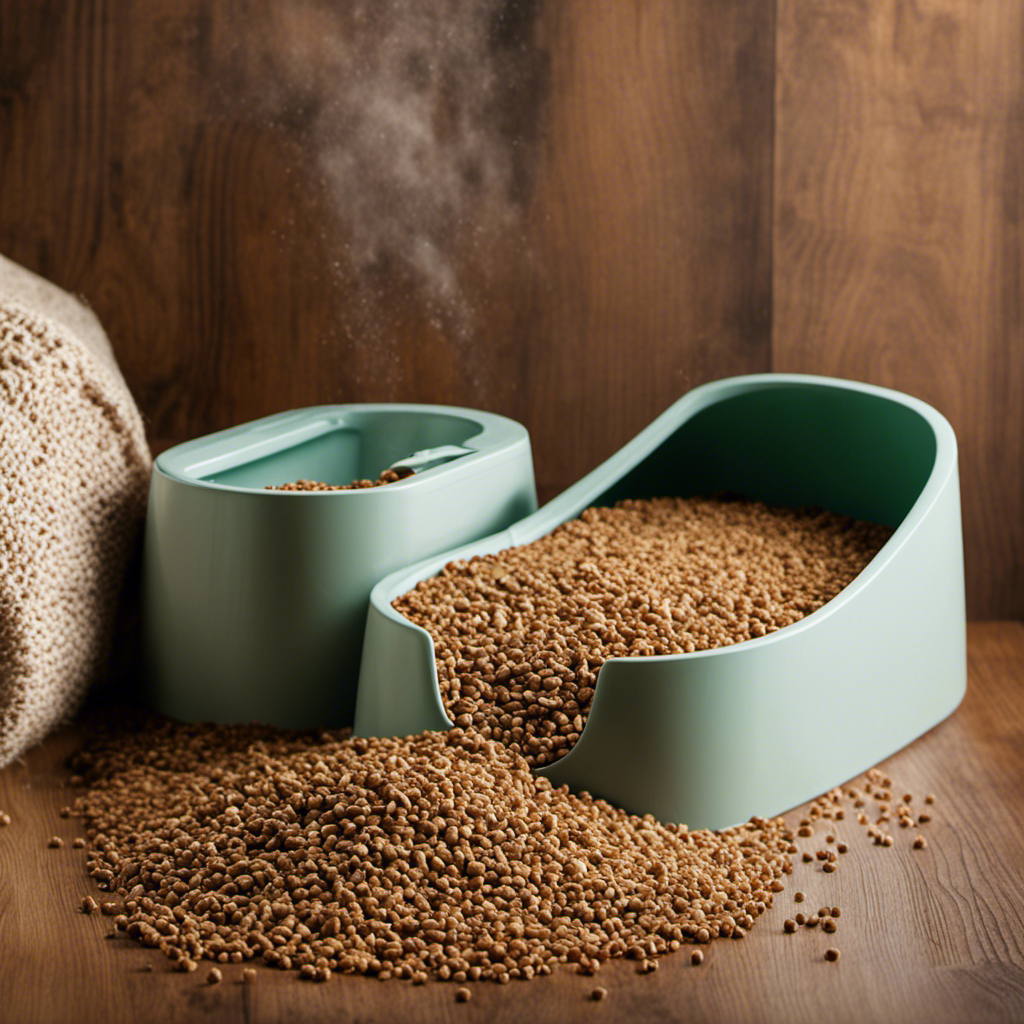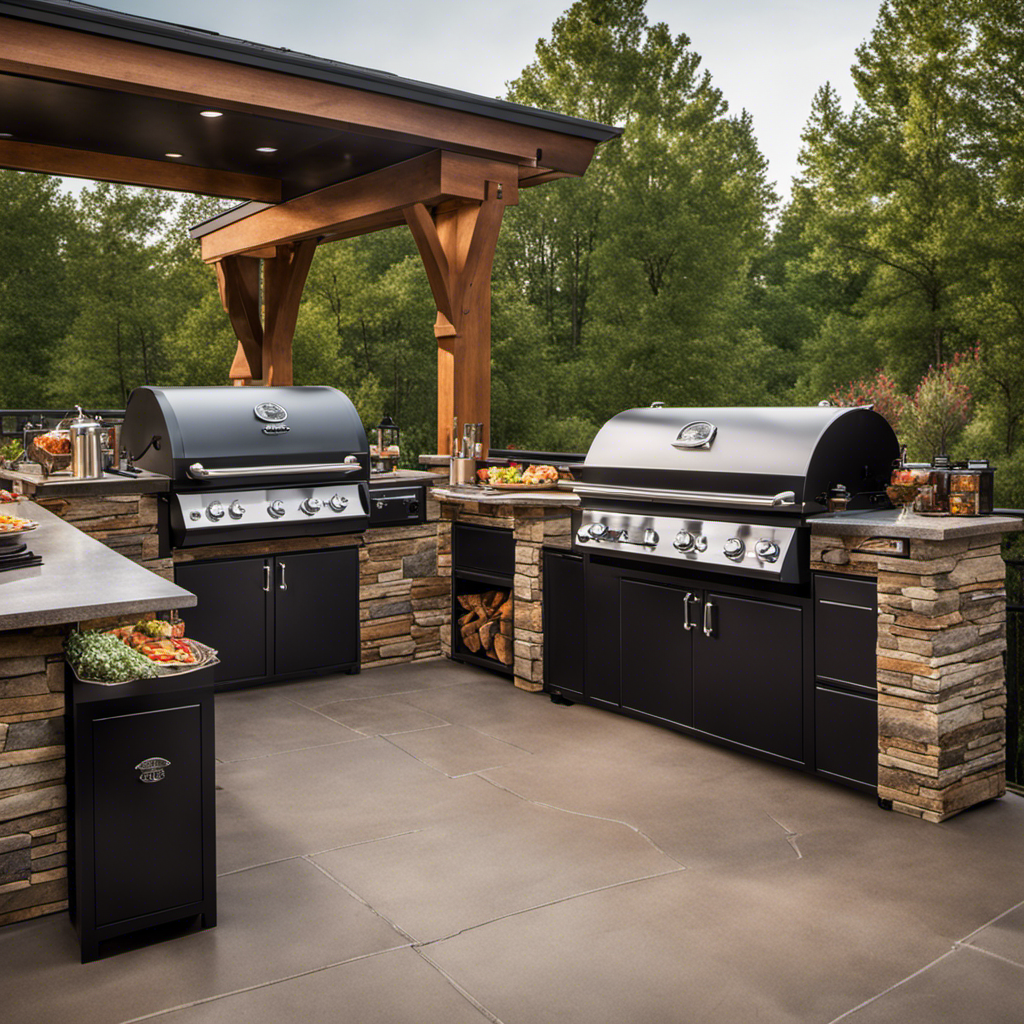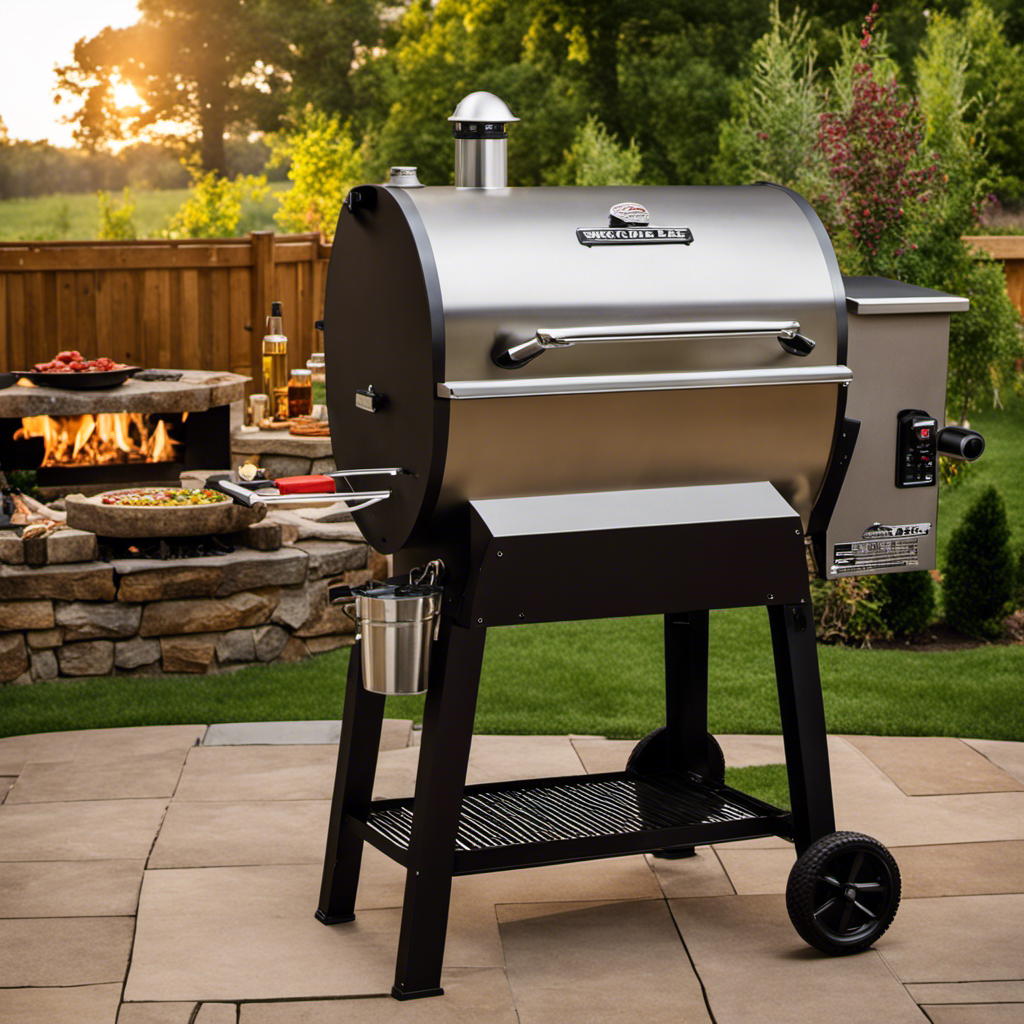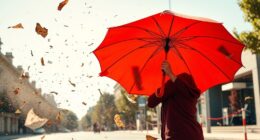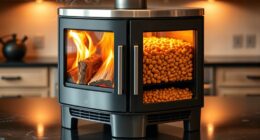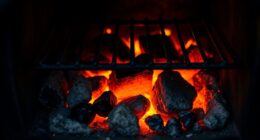Thinking about incorporating a pellet stove into your kitchen setup? Hold off on reaching for your pots and pans for a moment, as we explore reasons why a pellet stove might not be the ideal option for cooking needs.
From their limited heat distribution to their inability to simmer and slow cook, pellet stoves simply fall short in the culinary department.
But fear not, fellow foodies! We’ll explore why wood-burning stoves are the superior choice for all your cooking needs.
So, let’s dig in and discover why pellet stoves leave us hungry for more in the kitchen.
Key Takeaways
- Pellet stoves burn pellets made of compressed wood or biomass, but they are not suitable for cooking.
- Pellet stoves use a distribution blower to circulate hot air, not radiate heat like wood-burning stoves.
- The body of a pellet stove does not get hot enough to boil water, so boiling water on a pellet stove is not possible.
- Wood-burning stoves are recommended for cooking, while pellet stoves are a good alternative for heating homes.
The Limitations of Pellet Stove Cooking
We have learned that pellet stoves can’t be used for cooking due to their inability to radiate enough heat to boil water. While wood-burning stoves have the advantage of transferring heat differently, pellet stoves are better suited for heating homes.
Pellet stoves use a distribution blower to circulate hot air, rather than radiating heat like wood-burning stoves. Although pellet stoves have a hot stovetop, the rest of the stove remains cool, making it difficult to regulate temperature for simmering or slow cooking.
On the other hand, pellet stoves are a good alternative for heating homes, as they efficiently burn compressed wood pellets to circulate warm air with a blower. However, when it comes to preparing meals, it’s recommended to use a wood-burning stove for its superior cooking capabilities.
How Pellet Stoves Differ From Wood-Burning Stoves
When compared to wood-burning stoves, our experience has shown that pellet stoves have distinct differences in how they operate and perform.
Pellet stoves offer several benefits for heating, including their efficiency and ease of use. These stoves burn pellets made from compressed wood or biomass, which results in a cleaner and more controlled combustion process.
Additionally, pellet stoves produce fewer emissions and have a lower impact on air quality compared to traditional wood-burning stoves. This is because the pellets burn more efficiently and produce less smoke and particulate matter.
The use of pellet stoves can contribute to improved indoor and outdoor air quality, making them a more environmentally friendly option for heating.
The Heat Distribution Challenge
In our experience, the challenge lies in efficiently distributing heat from pellet stoves throughout a space. Here are some factors that contribute to this challenge:
-
Insufficient air circulation: The blower in pellet stoves may not be powerful enough to push the hot air evenly throughout the room, resulting in uneven heating.
-
Limited range: Pellet stoves typically have a limited range of heat distribution, which means that some areas of the room may be warmer than others.
-
Air quality concerns: The burning of wood pellets can release particulate matter and other pollutants into the air, which can have a negative impact on indoor air quality.
-
Maintenance requirements: Pellet stoves require regular cleaning and maintenance to ensure optimal performance and heat distribution.
-
Cost effectiveness: While pellet stoves can be cost-effective for heating, the efficiency of heat distribution can affect their overall effectiveness and cost savings.
Overall, while pellet stoves can be a cost-effective option for heating, the challenge lies in effectively distributing heat throughout the space and maintaining good indoor air quality.
Exploring the Types of Pellet Stoves
As we explore the types of pellet stoves, it’s important to consider their various features and capabilities. Pellet stoves come in different sizes and designs, each with its own efficiency and cost effectiveness. To help you make an informed decision, we have created a table that compares three common types of pellet stoves based on their heating capacity, efficiency, and cost.
| Type of Pellet Stove | Heating Capacity | Efficiency | Cost |
|---|---|---|---|
| Standard | 1,500 – 2,000 sq ft | 70 – 80% | $1,500 – $3,000 |
| Insert | 800 – 1,200 sq ft | 75 – 85% | $2,000 – $4,000 |
| Free-standing | 1,500 – 2,500 sq ft | 80 – 90% | $2,500 – $5,000 |
From the table, we can see that free-standing pellet stoves offer the highest heating capacity and efficiency, but also come with a higher cost. On the other hand, standard pellet stoves are more affordable but may not heat larger areas as effectively. It’s important to consider your heating needs and budget when choosing a pellet stove. By selecting the right type of pellet stove, you can maximize the efficiency and cost effectiveness of your heating system.
The Difficulty of Temperature Regulation
We found it challenging to regulate the temperature on our pellet stove for simmering or slow cooking. Despite its efficiency in heating our home, the temperature control capabilities of the pellet stove were lacking when it came to culinary pursuits. Here are some reasons why:
-
Inconsistent heat output: The pellet stove’s temperature fluctuated, making it difficult to maintain a constant simmer or slow cook.
-
Limited temperature range: The stove’s settings didn’t allow for precise control over low heat levels required for delicate cooking.
-
Slow response time: Adjustments to the temperature settings took time to take effect, leading to uneven cooking results.
-
Lack of direct heat: Unlike traditional stoves, pellet stoves don’t provide direct heat, making them less suitable for certain cooking techniques.
-
Alternative cooking options: Considering the challenges with pellet stoves, exploring alternative cooking methods such as gas or electric stoves would be a wise choice for those seeking more control over temperature regulation during cooking.
Debunking the Myth: Boiling Water on a Pellet Stove
Despite common misconceptions, boiling water on a pellet stove isn’t possible due to the stove’s limited heat output. Pellet stoves work by igniting compressed wood pellets to warm room air, but the body of the stove doesn’t get hot enough to boil water.
This is because pellet stoves use a distribution blower to circulate hot air, rather than radiating heat like wood-burning stoves. While pellet stoves have a hot stovetop, the rest of the stove stays cool.
Additionally, it’s difficult to regulate temperature for simmering or slow cooking on a pellet stove. Therefore, if you’re looking to boil water, it’s recommended to use alternative methods such as a traditional stovetop or an electric kettle.
The limited heat output of pellet stoves is one of the drawbacks when it comes to cooking.
Why Pellet Stoves Are Inefficient for Boiling Water
Boiling water on a pellet stove isn’t efficient due to its limited heat output and the use of a distribution blower instead of radiating heat like wood-burning stoves. Unlike wood-burning stoves, pellet stoves aren’t designed for cooking purposes. Here are the reasons why pellet stoves are inefficient for boiling water:
-
Limited heat output: Pellet stoves produce lower temperatures compared to wood-burning stoves, making it difficult to achieve boiling point.
-
Distribution blower: Pellet stoves rely on a distribution blower to circulate hot air, which isn’t ideal for direct heat transfer needed for boiling water.
-
Insufficient temperature control: Pellet stoves lack precise temperature control necessary for simmering or slow cooking.
-
Energy usage: Boiling water on a pellet stove would require the stove to run for longer periods, resulting in increased energy consumption.
-
Advantages of wood burning stoves: Wood-burning stoves offer better heat transfer, higher temperatures, and precise temperature control, making them more suitable for cooking.
Considering Pellet Stoves for Heating, Not Cooking
When considering pellet stoves for heating, it’s important to weigh the pros and cons.
One major advantage of pellet stoves is their energy efficiency. Pellets are made from compressed wood or biomass, which is a renewable energy source. This means that pellet stoves have a lower carbon footprint compared to traditional stoves that use fossil fuels. Additionally, pellet stoves have a high combustion efficiency, meaning they release less smoke and pollutants into the air.
Another benefit is the convenience of using pellets, as they can be easily stored and automatically fed into the stove.
However, there are some drawbacks to using pellet stoves. They require electricity to operate, so power outages can be an issue. Additionally, pellets can be more expensive than other heating fuels.
When comparing the energy efficiency of pellet stoves to traditional stoves, it’s important to consider factors such as insulation and overall efficiency of the heating system.
Why Wood-Burning Stoves Are the Superior Option for Cooking
In our experience, wood-burning stoves have proven to be the superior option for preparing meals. Why is that? Let’s explore the advantages of pellet stoves and alternative heating options.
- Wood-burning stoves radiate heat, providing even and consistent cooking temperatures.
- The aroma of burning wood adds a rustic and cozy atmosphere to the kitchen.
- With a wood-burning stove, you’ve the flexibility to adjust the heat intensity for different cooking techniques.
- The hot surface of a wood-burning stove allows for direct contact cooking, such as searing meats.
- Wood-burning stoves can also be used for baking, grilling, and smoking, expanding your culinary possibilities.
While pellet stoves have their benefits for heating homes, they fall short when it comes to cooking. So, if you’re looking to enhance your cooking experience, we highly recommend considering a wood-burning stove as your go-to option.
Are Pellet Stoves Safe to Use for Cooking?
Many people wonder about the fiery secret of pellet stoves and whether they are safe to use for cooking. While pellet stoves are designed for heating, some models come with cooking attachments. However, it’s crucial to follow safety guidelines and never use them for cooking unless the manufacturer specifies it.
– Are Pellet Stoves Safe for Cooking Despite Their Limitations?
Pellet stoves are convenient for heating, but using them for cooking has limitations. Despite the fiery secret of pellet stoves, they may not evenly distribute heat, making it challenging to cook food thoroughly. Additionally, they do not have the same level of control as traditional ovens or stovetops, so caution is essential.
Frequently Asked Questions
Can You Cook on a Pellet Stove?
Yes, you can cook on a pellet stove. Pellet stoves offer the benefit of a hot stovetop, but they fall short when it comes to cooking. Unlike wood-burning stoves, pellet stoves use a distribution blower to circulate hot air instead of radiating heat. This makes it difficult to regulate temperature for simmering or slow cooking.
Wood-burning stoves are recommended for preparing meals, while pellet stoves are a good alternative for heating homes.
How Do Pellet Stoves Differ From Wood-Burning Stoves?
Pellet stoves and wood-burning stoves differ in how they transfer heat.
While pellet stoves use a distribution blower to circulate hot air, wood-burning stoves radiate heat, making them ideal for cooking.
Wood-burning stoves have a hot stovetop, allowing for precise temperature control and better results when simmering or slow cooking.
In contrast, pellet stoves may have a hot stovetop, but the rest of the stove stays cool.
Therefore, if cooking is a priority, we recommend using a wood-burning stove for its advantages in preparing meals.
Why Is It Difficult to Regulate Temperature for Cooking on a Pellet Stove?
Regulating temperature and facing cooking challenges on a pellet stove can be difficult.
The hot stovetop of a pellet stove doesn’t radiate heat like a wood-burning stove, making it harder to control the temperature for simmering or slow cooking. Pellet stoves use a distribution blower to circulate hot air, not directly heat the cooking surface.
This, along with the stove’s cool exterior, limits its suitability for cooking. Wood-burning stoves are recommended for better heat transfer and more precise temperature regulation.
Is It Possible to Boil Water on a Pellet Stove?
Yes, it’s possible to boil water on a pellet stove. However, pellet stoves aren’t designed for cooking and have limitations.
While the body of the stove doesn’t get hot enough to boil water, it can still provide some heat for basic cooking needs.
It’s important to note that there are better alternative cooking methods available, such as using a wood-burning stove, which is specifically designed for preparing meals.
Why Are Wood-Burning Stoves Recommended for Cooking Instead of Pellet Stoves?
Wood-burning stoves are recommended for cooking instead of pellet stoves due to their advantages and the disadvantages of using pellet stoves for cooking.
Wood-burning stoves transfer heat differently, making them better for preparing meals. They provide a consistent and adjustable heat source, allowing for precise temperature control.
On the other hand, pellet stoves use a distribution blower to circulate hot air, making it difficult to regulate temperature for simmering or slow cooking. Additionally, while pellet stoves have a hot stovetop, the rest of the stove stays cool, limiting their functionality in cooking.
Conclusion
In conclusion, pellet stoves are simply not up to the task when it comes to cooking. Their limitations in heat distribution and temperature regulation make them inefficient for simmering, slow cooking, and boiling water.
If you want a stove that can handle all your culinary needs, look no further than a wood-burning stove. With superior heat transfer capabilities, wood-burning stoves are the true champions in the kitchen.
Don’t settle for anything less when it comes to preparing your meals.
Growing up surrounded by the vast beauty of nature, Sierra was always drawn to the call of the wild. While others sought the comfort of the familiar, she ventured out, embracing the unpredictable and finding stories in the heartbeat of nature.
At the epicenter of every remarkable venture lies a dynamic team—a fusion of diverse talents, visions, and passions. The essence of Best Small Wood Stoves is crafted and refined by such a trio: Sierra, Logan, and Terra. Their collective expertise has transformed the platform into a leading authority on small wood stoves, radiating warmth and knowledge in equal measure.

